| Baccala or salted codfish |
One of the many loves that I have developed and nurtured since moving to Italy isbaccalà. I get very excited every time I see it on the menu, especially as it is dished up and cooked in a variety of different ways depending upon the region. For most Italians, baccalà is salted codfish, except for the biggest consumers of this imported white fish, the Italians from the Veneto region, where the word baccalà is for unsalted codfish, this being referred to in all other areas of Italy as stockfish. Thus in Italy,baccalà is the word referring to the same fish, however, it is typically unsalted in the Veneto (stockfish to all other Italians) and salted to all other regions, such as in Tuscany.
Imported to Italy from the fifteenth century initially through Venice, baccalà is still today a daily feature in the diet of the Italians from this region, whereas in Florence it appears on the menus typically on Fridays only. One commonly told story recounts that the importation of this versatile fish to Italy dates to 1432 when the Venetian captain Pietro Querini and his crew were shipwrecked on the island of Rost, south of the Lofoten islands off Norway, and to survive they fished and ate the local stockfish, known as baccala, which they continued to eat after returning home.
After the Italian, John Cabot, discovered Newfoundland in 1497, the greater trade routes of cold Atlantic seas made for much greater importation and from the sixteenth century onwards, codfish became continually more widespread in Italian cuisine. It is cheap and the two different preservation procedures used, air drying and salting (similar to that of prosciutto), meant that it was accessible to the poor and was able to be used on Fridays for inland towns when fresh fish wasn’t available.
| Salted baccala at the Sant’ Ambrogio Market in Florence on Friday, ready to cook. |
The fisherman splits the three to six foot long cod along the belly and discards the backbone, leaving a small portion above the tail. For the salting technique, the codfish is then heavily salted and tightly stacked in many layers. As the cod’s salt bearing cells begin to erupt in reaction to the salt, the liquid is removed and more salt is added. This process continues for about ten days when the water content is under 40% and the fish can be preserved for up to one year. When used for cooking, it must be soaked for up to 48 hours, to rehydrate and remove the percentage of the salt content. The soaking liquid should be changed at least three times during the 48 hours. For the air drying technique, the codfish is immediately treated after being caught and put on supports and left in the open air from February to May. The cold and dry climate, typical of the Scandinavian area, is perfect for this process. With a temperature ideally below zero it protects the fish from bacteria and insects. After the three months out in the open, it matures in a dry and well ventilated area for a further two to three months. After this process the codfish has lost 70% of its water content but retains most of its nutrients. It is rich in protein, iron salts and calcium.
Baccala mantecato, also called baccala alla veneziana or ‘Venetian style’, is one of the things that I hold close to my heart. The rehydrated air dried codfish (stockfish) is mushed up and mixed with anchovies, oil and milk to form a paste (looks a bit like dense cottage cheese) and then spread in abundance on grilled polenta, or a crostino (small baguette slice). You can find this in the many baccaro bars (traditional tapas like bars in Venice) scattered around the city, and it is a perfect little snack when you meet your mates for an ombra (the Venetian word for an aperitif), ideal at anytime during the day.
 |
| Baccala mantecato |
Baccala alla vicentina, ‘Vicenza style’, is also stockfish (air dried codfish) and the fish is kept in large flakes or small bite size pieces and prepared with similar ingredients as in Venice. It is eaten more often as a meal and served with soft polenta.
| Baccala alla vicentina |
In Tuscany, on Fridays, in local trattorias, baccala alla livornese, Livorno style, will be very often on the menu. In fact, you can find already unsalted baccalà at the local food markets on Fridays so that families can cook it easily at home, avoiding the time consuming de-salting process. Livorno is the largest port in Tuscany, and the way that the Tuscans eat the salted cod is in a fillet, pan-fried, with peeled fresh tomatoes, parsley and garlic.
 |
| Baccala alla livornese |
Baccala alla romana, Roman style, is deep fried, it is also called baccala fritto alla giudia, fried Jewish style, referring to its possible origin from the Roman Jewish ghetto. There are still some little traditional local bars in Rome, one just off the campo dei Fiori in the historical centre, which cooks this as a snack, and it also features often on the menus.
 |
| Baccala alla romana |
In Venice I recently had a fabulous plate of baccala mantecato and baccala alla vicentina as a starter in the restaurant ‘Antica Adelaide’ situated in the Cannaregio area. The menu here is predominately Venetian cuisine.
My favourite baccala alla livornese to date in Florence is at ‘La Casalinga’ near piazza Santa Spirito, made on Fridays only. If you are keen on trying it, aim to go at lunch time as there may not be any left by dinner time!





